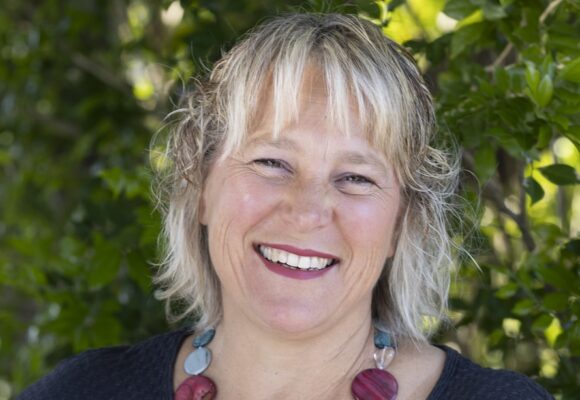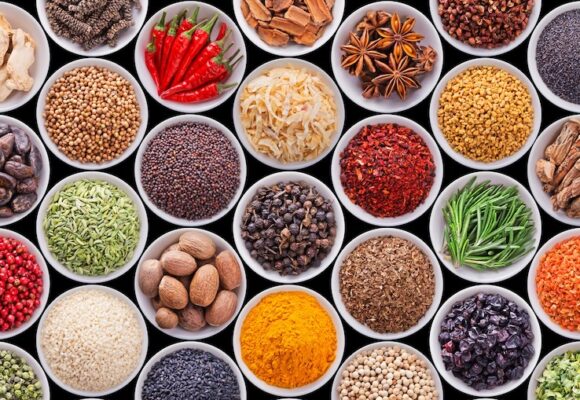How do you train a macadamia tree to produce more macadamia nuts? That’s the question at the heart of the Small Tree – High Productivity initiative that’s seeking to transform the productivity and efficiency of not only macadamia orchards, but also mangoes and avocados.
The initiative is trialling a range of methodologies inspired by the productivity gains of the apple industry, which has focused on intensification, shifting from orchards with big old trees to smaller individual trees. Principal Horticulturalist Dr John Wilkie is working with a team of more than 30 scientists trialling higher density plantings in macadamia, mango and avocado orchards, as well as trellising, limb bending and dwarf rootstocks.

Dr John Wilkie, Principal Horticulturalist of the Small Tree – High Productivity initiative
Led by the Queensland Department of Agriculture and Fisheries in collaboration with the Queensland Alliance for Agriculture and Food Innovation at the University of Queensland and the New South Wales Department of Primary Industries, the project is co-funded by Hort Innovation* and other research partners. It’s hoped the findings will identify ways to achieve higher maximum yields that occur earlier in the life of the orchard, effectively delivering positive cash flow sooner.
The research is examining four key components of orchard productivity, being vegetative vigour (the amount of leaves, shoots, branches and trunk grown by the tree), the amount of light captured by the tree and distributed through its canopy, tree structure and crop load (the amount of fruit/nuts on a tree).
John says these elements are considered from the viewpoint of the orchard as an intricate system. “When you alter one, it affects the others. So we work on the components of the system but we also try and understand how they interact with each other,” he explains.
Can imitation lead to innovation?
John gained experience with macadamia and mango crops early in his career before shifting his focus to apples around 2009. It was during this period that he was introduced to innovative tree management techniques that had delivered significant productivity gains for the apple industry. “I was continually asking myself “Why can’t we do this with our macadamia and mango crops?” he reveals.
It turns out other staff at the Department of Agriculture and Fisheries were asking the same thing. “Our management had been wanting to do something along these lines for a while, to try and boost the sub-tropical and tropical tree crop industries, because it was understood the productivity was not where it should be,” John says. “The trees were underdeveloped, and there were a number of us that saw opportunities there. Fortunately we were able to obtain the funding needed to investigate it further.”
The project team is working to transform macadamia, mango and avocado orchards, without necessarily reinventing the wheel. “We’re trying to use the accumulated knowledge of older tree crops in an attempt to transform newer ones. Apples have done all this over the past 40 years, so we want to adapt some of the productivity improvement principles they have used to bring about similar gains in other tree crops,” John explains.
He draws a parallel between the work his team is doing and the massive leap forward The Green Revolution delivered to rice and other cereal crops in the 1960s.
“It’s a similar fundamental concept,” he says. “The Green Revolution saw a shift to shorter rice and wheat plant varieties that allowed greater partitioning of the plant’s energy into the harvestable product, and this reduced the amount of energy that was put into unproductive material. That’s one of the main things we’re trying to do as well – transform the way energy is used by a tree, to ultimately deliver more of what you can sell per hectare,” explains John. Put simply: more fruit, less wood.
Smaller trees for bigger returns
John says apple orchard systems once resembled those of today’s macadamia orchards. The trees were vigorous and large, and planted at low densities with limited tree training or pruning.
But the apple industry discovered the benefits of planting lots of smaller trees per hectare, and maintaining each tree at a small size. Particular methods of pruning and training also delivered advantages, triggering the trees to produce fruit more quickly, and delivering much higher final yields, while a switch from vigorous rootstocks to dwarfing rootstocks made the final size of the trees considerably smaller. In short, the apple industry learned how to better manage its crop load to achieve superior yield and quality.
The results of these changes speak for themselves. A typical ‘old system’ apple orchard in the 1970s produced around 10-15 tonnes per hectare.
Fast forward 40 years, and growers who have adopted the modern orchard systems are consistently yielding 60-100 tonnes per hectare. With improvements of this magnitude, it’s understandable that when John looks at today’s macadamia orchards, with their large, untrained trees on vigorous rootstock, he sees a world of potential.
Innovative experimentation
The initiative has seen the establishment of trials with growing techniques rarely, if ever, seen in the macadamia industry.
In the project’s Bundaberg trial, the team is testing a high-density trellising system. “It’s very different to what people are used to seeing. For macadamias I’m not aware it’s been done anywhere before,” says John. Trellising has been used successfully with apple crops, and is a tool that enables the tree to be pruned and trained in a particular way.
The team is also trialling limb bending, another tool used in apple crops. John explains, “If there’s a limb that’s shooting towards the sky, it’s bent down and tied with string to either the trellis wire or another part of the tree. In apples it’s used as a method to moderate the vigour.”
The research is making the most of cutting edge technology in an attempt to reach its findings sooner. Functional structural plant modelling – a type of computer modelling – is delivering multiple benefits.
“The computer modelling specialists we’re working with on this are at the cutting edge of this technology,” says John. “They’re actually developing new ways of modelling for us, where they essentially grow trees and whole orchards on the computer, and see how light moves through the orchard, and how the flowers, fruit and shoots compete with each other. This allows us to run simulations and hopefully narrow down some of the field experiments we will have to do.”
A long-term approach
While the research is a five-year project with funding committed until the end of 2018, John says it’s important to take an even longer-term view. “We’re trying to redesign how orchards are planted and managed from very early on,” he says. “It’s going to be 20 years to really get a good handle on the results we can expect to see in macadamias, mangoes and avocados.”
It’s hoped the project’s ultimate outcome will be a new, more productive system that macadamia growers can follow. “The research involves a lot of underlying science, but the final aim is not the science, it’s the improved system for industries,” he explains.
If the work is successful, one result could be macadamia orchards that look physically different to those found in major growing regions currently. “If our research is successful and follows the general trend that apples did, then I would expect to see new orchards looking quite different,” he says.
A continued commitment to R & D
Australia has been at the forefront of research and development for the macadamia industry for some time. With global demand for macadamias strong, and significant growth anticipated over the coming years, it’s important that smarter farming methods continue to be developed to ensure maximum productivity for every hectare of land under planting.
The Small Tree – High Productivity initiative is mining the accumulated knowledge of the much older apple industry, to speed up the returns of the significantly younger macadamia industry. If the project is ultimately able to bring forward the time to maximum yield of a macadamia orchard, it could prove to be another crucial element in building market confidence in macadamia investment and supply.
For any further information on this initiative, please contact Lynne Ziehlke.
*The project Transforming subtropical/tropical tree crop productivity (AI13004) is a strategic levy investment under the Hort Innovation Avocado, Macadamia and Mango Funds.


